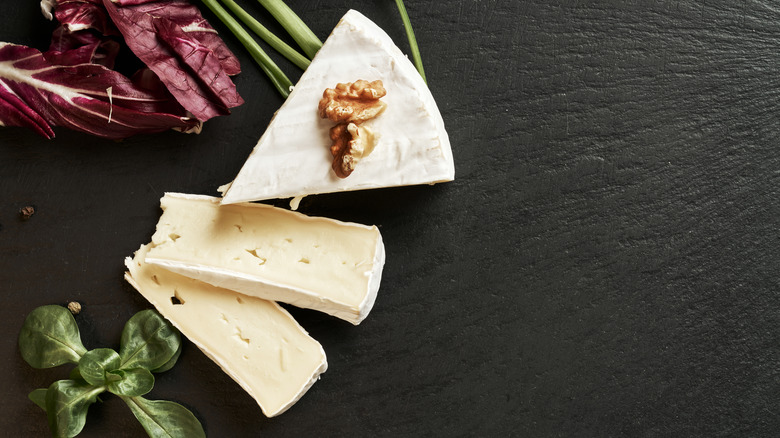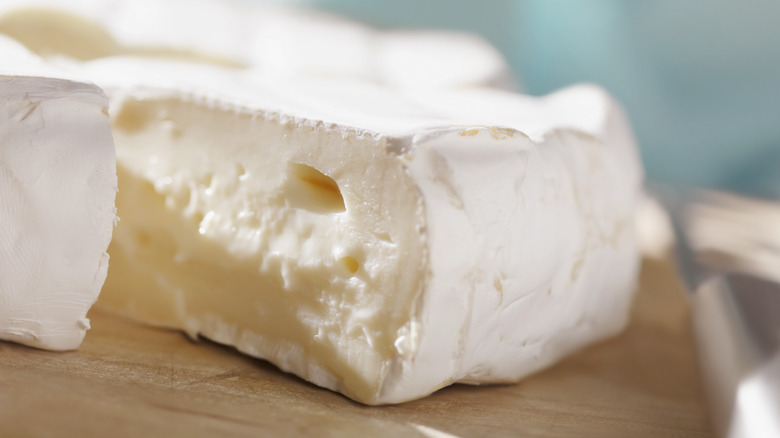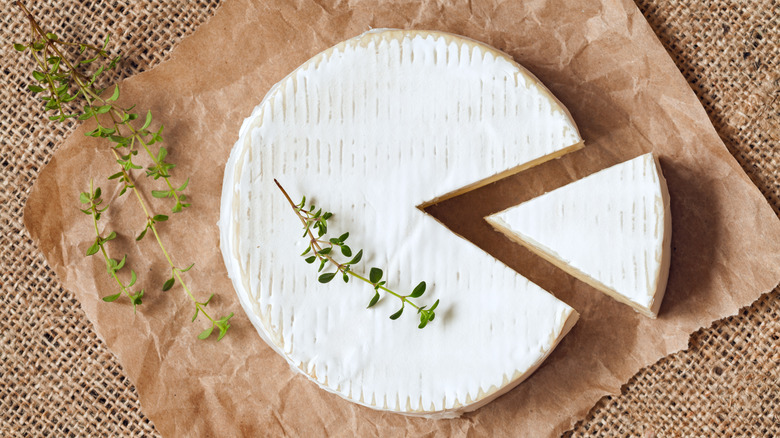How To Eat Brie Like You Know What You're Doing
Brie, with its elegant appearance and creamy texture, is a popular cheese that is often associated with sophistication and gourmet dining. Originating near Paris in northeastern France and made primarily from cow's milk, Brie has been part of the French cheese canon since the eighth century — which can make it somewhat intimidating to those who are new to it. Renowned for its soft, buttery interior encased in a delicate white rind (Penicillium candidum), brie is one of the most easy-to-find gourmet cheeses — even when you're cheese shopping on a budget. That doesn't make it easy to understand — or serve — however.
Like many artisanal cheeses, brie needs to be stored and served in certain ways to preserve its flavor and texture. Show off your cheese knowledge and impress your dinner guests by making sure you observe some of the rules. They include serving brie at room temperature to maximize its flavor profile, cutting the cheese in thin wedges to ensure each bite contains every part of the cheese, and eating the rind instead of digging for the inside. Storing your cheese in breathable wrapping will also make sure your cheese is at the peak of its ripeness and flavor.
Best ways to serve and eat brie
Brie cheese is best enjoyed at room temperature, so remove the cheese from the refrigerator at least 30 minutes before serving. The warmer the environment, the less time you'll need to let it sit. This allows the cheese to soften, enhancing its creamy texture and releasing its full spectrum of flavors. The edible mold on the rind also releases an ammonia-like smell, which can be trapped if the cheese is wrapped in non-porous materials such as plastic wrap. Uncovering the cheese and bringing it to room temperature will dispel the unpleasant aroma and improve its taste.
The way you cut into a piece of brie can also have an impact on its taste and texture. Since brie is aged differently from the middle outwards, it is considered rude to cut off the tip of the wedge — also known as pointing — as it would prevent others from enjoying the full spectrum of flavor. Instead, cut a thin wedge from the larger one, so you can taste and appreciate every part of the cheese without hoarding the delicious center. The white rind of brie is entirely edible, and its taste contributes to the overall experience. If aged properly, the creamiest and softest of the cheese is just under the rind. Therefore, it is considered rude to only eat the inside. However, if the rind is intimidating, start with thin slices, so you get more of the inner gooey bits than skin.
More serving and pairing tips
Aside from bringing it to temperature and slicing it properly, there are several other helpful tips for serving brie. For example, since brie is a rather soft cheese (although not as soft as goat cheese or fresh mozzarella), a thin and sharp blade, or a cheese wire, is the perfect implement to cut the cheese in neat wedges. Traditionally eaten with crusty breads, serve the cheese alongside a whole baguette, so your guests can tear off bite-sized pieces to go with the cheese. It also pairs spectacularly with an Aperol spritz.
Since cheeses are best when wrapped in breathable materials, store your leftover cheese with parchment paper — since plastic wraps trap moisture and will promote bacterial and mold growth, spoiling the cheese quickly. In the fridge, store your cheese in a dedicated drawer and away from strong-smelling items, so it will not absorb other aromas while stored. Even when stored properly, brie is a rather delicate cheese, so it is best to consume it within a few days to appreciate its peak flavor.



